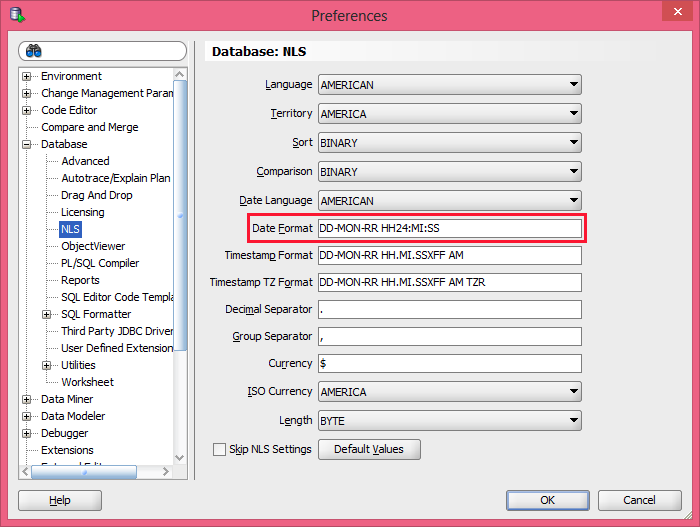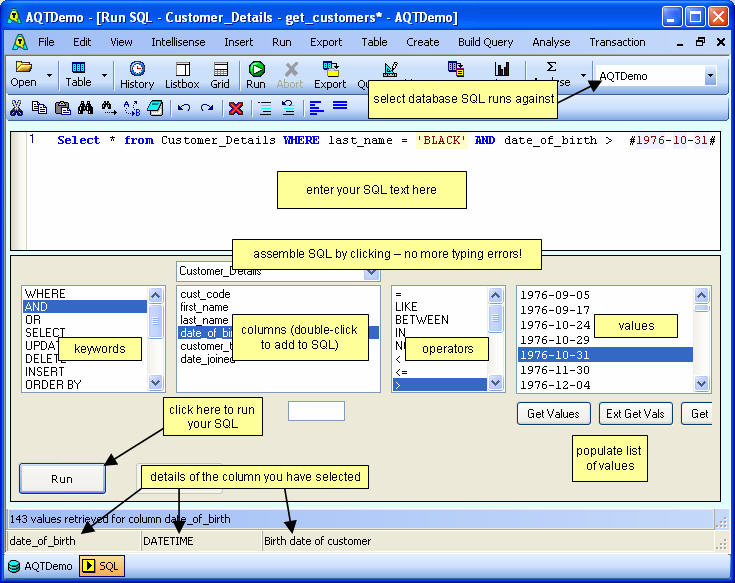Update Long Datatype Column Oracle
- 9 Comments!

When I try to query objects, I end up with following error: ORA-01461: can bind a LONG value only for insert into a LONG column Could someone please help me on the. Preprocessor Directives The C/C++ preprocessor directives that work with Pro*C are #include and #if. Pro*C does not recognize #define. For example, the following code.
Datatypes. Each value manipulated by Oracle Database has a datatype. The datatype of a value associates a fixed set of properties with the value. These properties cause Oracle to treat values of one datatype differently from values of another.
Oracle alter table change column datatype. You can use the Oracle "alter table" syntax to change the data type for an existing column, as shown in this example. ORA-00997 Illegal use of long datatype tips. Oracle Database Tips by Donald BurlesonFebruary 12, 2015.
For example, you can add values of NUMBER datatype, but not values of RAW datatype. When you create a table or cluster, you must specify a datatype for each of its columns. When you create a procedure or stored function, you must specify a datatype for each of its arguments. These datatypes define the domain of values that each column can contain or each argument can have.
For example, DATE columns cannot accept the value February 2. SHOE'. Each value subsequently placed in a column assumes the datatype of the column. For example, if you insert '0. JAN- 9. 8' into a DATE column, then Oracle treats the '0. JAN- 9. 8' character string as a DATE value after verifying that it translates to a valid date. Oracle Database provides a number of built- in datatypes as well as several categories for user- defined types that can be used as datatypes.

LONG is an Oracle data type for storing character data of variable length up to 2 Gigabytes in length (bigger version of the VARCHAR2 datatype). Note that a table can. Tuning with equivalent SQLs - a little challenge; Row Limiting Clause for Top-N Queries in Oracle Database 12c Release 1 (12.1) Compression test, 12cR2. Introduction to Oracle Datatypes. Each column value and constant in a SQL statement has a datatype, which is associated with a specific storage format, constraints. Each value manipulated by Oracle Database has a datatype. The datatype of a value associates a fixed set of properties with the value.
The syntax of Oracle datatypes appears in the diagrams that follow. The text of this section is divided into the following sections: A datatype is either scalar or nonscalar. A scalar type contains an atomic value, whereas a nonscalar (sometimes called a . A large object (LOB) is a special form of scalar datatype representing a large scalar value of binary or character data. LOBs are subject to some restrictions that do not affect other scalar types because of their size.
Those restrictions are documented in the context of the relevant SQL syntax. The Oracle precompilers recognize other datatypes in embedded SQL programs. These datatypes are called external datatypes and are associated with host variables. Do not confuse built- in datatypes and user- defined types with external datatypes.
For information on external datatypes, including how Oracle converts between them and built- in datatypes or user- defined types, see Pro*COBOL Programmer's Guide, and Pro*C/C++ Programmer's Guide. The ANSI- supported datatypes appear in the figure that follows. Other Oracle- supplied types follow: Oracle Built- in Datatypes. The table that follows summarizes Oracle built- in datatypes. Please refer to the syntax in the preceding sections for the syntactic elements. The codes listed for the datatypes are used internally by Oracle Database. The datatype code of a column or object attribute is returned by the DUMP function.
Table 2- 1 Built- in Datatype Summary. Code. Datatype. Description. VARCHAR2(size . Maximum size is 4. You must specify size for VARCHAR2. BYTE indicates that the column will have byte length semantics; CHAR indicates that the column will have character semantics. NVARCHAR2(size)Variable- length Unicode character string having maximum length size characters.
The number of bytes can be up to two times size for AL1. UTF1. 6 encoding and three times size for UTF8 encoding. Maximum size is determined by the national character set definition, with an upper limit of 4. You must specify size for NVARCHAR2. NUMBER. The precision p can range from 1 to 3. The scale s can range from - 8.
LONGCharacter data of variable length up to 2 gigabytes, or 2. Provided for backward compatibility. DATEValid date range from January 1, 4. BC to December 3. AD. The default format is determined explicitly by the NLS. The size is fixed at 7 bytes.
This datatype contains the datetime fields YEAR, MONTH, DAY, HOUR, MINUTE, and SECOND. It does not have fractional seconds or a time zone. BINARY. This datatype requires 5 bytes, including the length byte.
BINARY. This datatype requires 9 bytes, including the length byte. TIMESTAMP . Accepted values of fractional. The default is 6. The default format is determined explicitly by the NLS. The sizes varies from 7 to 1. This datatype contains the datetime fields YEAR, MONTH, DAY, HOUR, MINUTE, and SECOND. It contains fractional seconds but does not have a time zone.
TIMESTAMP . Accepted values are 0 to 9. The default is 6. The default format is determined explicitly by the NLS. The size is fixed at 1. This datatype contains the datetime fields YEAR, MONTH, DAY, HOUR, MINUTE, SECOND, TIMEZONE. It has fractional seconds and an explicit time zone. TIMESTAMP . The sizes varies from 7 to 1.
INTERVALYEAR . Accepted values are 0 to 9. The default is 2. The size is fixed at 5 bytes. INTERVALDAY . Accepted values are 0 to 9.
The default is 2. Accepted values are 0 to 9. The default is 6. The size is fixed at 1. RAW(size)Raw binary data of length size bytes.
Maximum size is 2. You must specify size for a RAW value. LONG RAWRaw binary data of variable length up to 2 gigabytes. ROWIDBase 6. 4 string representing the unique address of a row in its table. This datatype is primarily for values returned by the ROWID pseudocolumn. UROWID . The optional size is the size of a column of type UROWID. The maximum size and default is 4.
CHAR . Maximum size is 2. Default and minimum size is 1 byte. BYTE and CHAR have the same semantics as for VARCHAR2. NCHAR. The number of bytes can be up to two times size for AL1. UTF1. 6 encoding and three times size for UTF8 encoding.
Maximum size is determined by the national character set definition, with an upper limit of 2. Default and minimum size is 1 character. CLOBA character large object containing single- byte or multibyte characters.
Both fixed- width and variable- width character sets are supported, both using the database character set. Maximum size is (4 gigabytes - 1) * (database block size). NCLOBA character large object containing Unicode characters. Both fixed- width and variable- width character sets are supported, both using the database national character set. Maximum size is (4 gigabytes - 1) * (database block size). Stores national character set data.
BLOBA binary large object. Maximum size is (4 gigabytes - 1) * (database block size). BFILEContains a locator to a large binary file stored outside the database. Enables byte stream I/O access to external LOBs residing on the database server. Maximum size is 4 gigabytes.
The sections that follow describe the Oracle datatypes as they are stored in Oracle Database. For information on specifying these datatypes as literals, please refer to . They are less restrictive than other datatypes and consequently have fewer properties. For example, character columns can store all alphanumeric values, but NUMBER columns can store only numeric values. Character data is stored in strings with byte values corresponding to one of the character sets, such as 7- bit ASCII or EBCDIC, specified when the database was created. Oracle Database supports both single- byte and multibyte character sets. These datatypes are used for character data: For information on specifying character datatypes as literals, please refer to .
Oracle ensures that all values stored in a CHAR column have the length specified by size. Download Call Of Duty 1 Pc Blogspot. If you insert a value that is shorter than the column length, then Oracle blank- pads the value to column length. If you try to insert a value that is too long for the column, then Oracle returns an error. The default length for a CHAR column is 1 byte and the maximum allowed is 2.
A 1- byte string can be inserted into a CHAR(1. When you create a table with a CHAR column, by default you supply the column length in bytes. The BYTE qualifier is the same as the default.
If you use the CHAR qualifier, for example CHAR(1. CHAR), then you supply the column length in characters. A character is technically a code point of the database character set. Its size can range from 1 byte to 4 bytes, depending on the database character set. The BYTE and CHAR qualifiers override the semantics specified by the NLS. For performance reasons, Oracle recommends that you use the NLS.
See Oracle Database Globalization Support Guide for more information on character set support. NCHAR Datatype The NCHAR datatype is a Unicode- only datatype.
When you create a table with an NCHAR column, you define the column length in characters.